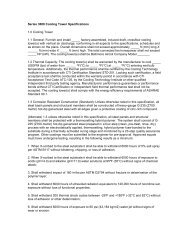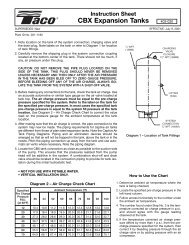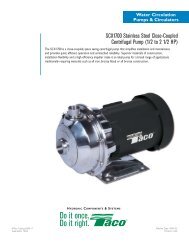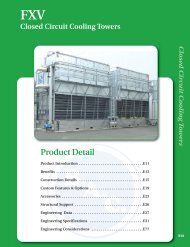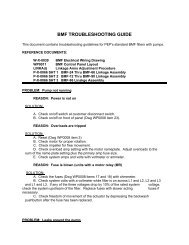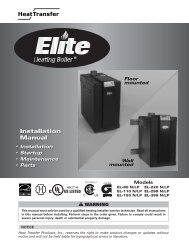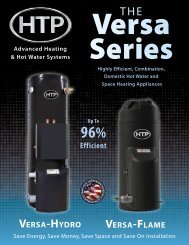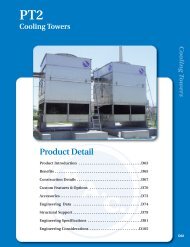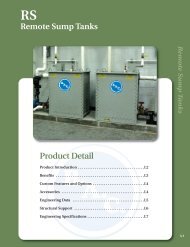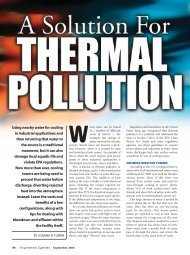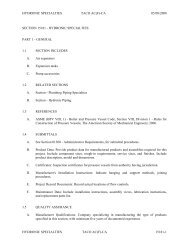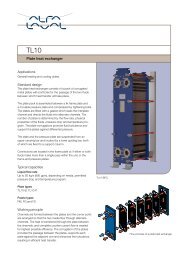1600 Series In-Line Pump - Taco-Hvac
1600 Series In-Line Pump - Taco-Hvac
1600 Series In-Line Pump - Taco-Hvac
- No tags were found...
Create successful ePaper yourself
Turn your PDF publications into a flip-book with our unique Google optimized e-Paper software.
9.<strong>In</strong> other words, <strong>Pump</strong> 2 overpowers <strong>Pump</strong> 1. For thisreason, with <strong>Pump</strong> 2 running alone, <strong>Pump</strong> 1 should not bestarted unless <strong>Pump</strong> 2 operates to the right of the pointwhere the curve of <strong>Pump</strong> 2 and the curve of <strong>Pump</strong>s 1 and2 diverge (100 GPM) in Fig.3–6.Parallel pumping is often an excellent way to obtainoptimum operating conditions and to save energy. To besuccessful, however, systems and operating conditions mustbe understood. This applies to both stable and unstablepump curves.Part IV – NPSH And <strong>Pump</strong> CavitationThe net positive suction head (NPSH) is an expression ofthe minimum suction conditions required to preventcavitation in a pump. NPSH can be thought of as the headcorresponding to the difference between the actual absolutepressure at the inlet to the pump impeller and the fluidvapor pressure. An incorrect determination of NPSH canlead to reduced pump capacity and efficiency, severeoperating problems and cavitation damage.It is helpful to define separately two basic NPSH considerations;required NPSH (NPSHR) and available (NPSHA).The required or minimum NPSH is dependent on the designof a particular pump and is determined by the manufacturer’stesting of each pump model. The pump manufacturer can plotthis required NPSH for a given pump model on performancecurve and this value, expressed as feet of the liquid handled,is the pressure required to force a given flow through thesuction piping into the impeller eye of the pump. RequiredNPSH can also be defined as the amount of pressure inexcess of the vapor pressure required by a particular pumpmodel to prevent the formation of vapor pockets orcavitation. Required NPSH, then, varies from one pumpmanufacturer to the next and from one manufacturer’s modelto another. The required NPSH for a particular pump modelvaries with capacity and rapidly increases in high capacities.The available NPSH, on the other hand, is dependent on thepiping system design as well as the actual location of thepump in that system. The NPSH available as a function ofsystem piping design must always be greater than the NPSHrequired by the pump in that system. The NPSH availableas a function of system piping design must always be greaterthan the NPSH required by the pump in that system or noiseand cavitation will result. The available NPSH can be alteredto satisfy the NPSH required by the pump, if changes in thepiping liquid supply level, etc., can be made. <strong>In</strong>creasing theavailable NPSH provides a safety margin against the potentialfor cavitation. The available NPSH is calculated by using theformula:NPSHA = ha +/- hs - hvpa – hfwhere:ha = atmospheric pressure in feet absolutehs “+” = suction head or positive pressure in a closedsystem, expressed in feet gaugehs “-” = suction lift or negative pressure in a closed system,expressed in feet gaugehvpa = vapor pressure of the fluid in feet absolutehf = pipe friction in feet between pump suctionand suction reference point.Cavitation can be defined as the formation and subsequentcollapse of vapor pockets in a liquid. Cavitation in a centrifugalpump begins to occur when the suction head is insufficientto maintain pressures above the vapor pressure. As the inletpressure approaches the flash point, vapor pockets form bubbleson the underside of the impeller vane which collapse as theymove into the high-pressure area along the outer edge of theimpeller. Severe cavitation can cause pitting of the impellersurface and noise levels audible outside the pump.The <strong>Taco</strong> pump performance curve below (Fig. 4–1) includesa plot of the required NPSH for a <strong>Taco</strong> Model 1506. If apump capacity of 105 GPM is used as an example capacityrequirement, reading vertically from that GPM rate shows arequired NPSH of 4 feet. An available system NPSH greaterthan 4 feet would, therefore, be necessary to ensuresatisfactory pump performance and operation.HEAD IN FEET5040302010L/SEC6.25"(159mm)5.75"(146mm)5.25"(133mm)4.75"(121mm)4.25"(108mm)Curve no. 2015Min. Imp. Dia. 4.25"Size 2 x 1.5 x 624 6 8 101 3 5 7 9 1100 00 25 50 75 100 125 150 175 200FLOW IN GALLONS PER MINUTEMS 2-18-02 PC-2015 RevB ECN10627Fig. 4-142%46%CURVES BASED ON CLEAR WATERWITH SPECIFIC GRAVITY OF 1.0Model 1506CI & FI <strong>Series</strong>54%.33HP(.25KW)57%60%63%1760 RPMAugust 9, 2001REQUIRED NPSH64.5%63%60%.5HP(.37KW)57%54%.75HP(.56KW)46%42%1HP(.75KW)1.5HP(1.1KW)FEET2 60 012111098765432 201KPa8 246 184 12HEAD IN METERSNPSH1201101009080706050403010HEAD IN KILOPASCALS




